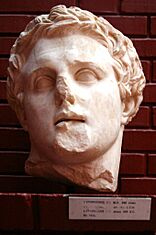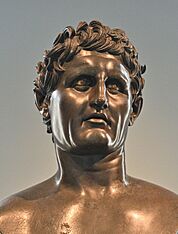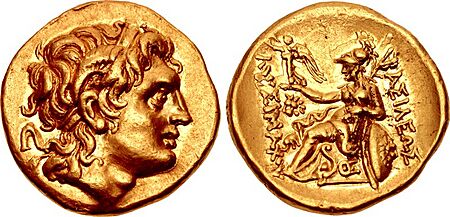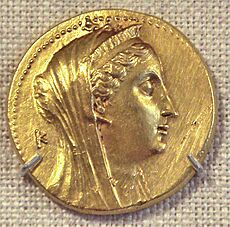Ptolemy Ceraunus facts for kids
Quick facts for kids Ptolemy Ceraunus |
|
|---|---|
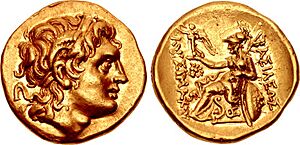
Stater of Ptolemy Keraunos
|
|
| King of Macedon | |
| Reign | 281 – 279 BC |
| Predecessor | Lysimachus |
| Successor | Meleager |
| Born | ca. 319 BC Alexandria |
| Died | January/February 279 BC |
| Spouse | Unknown woman (possibly daughter of Lysimachus) Arsinoe II of Egypt |
| Greek | Πτολεμαῖος Κεραυνός |
| House | Ptolemaic dynasty |
| Father | Ptolemy I Soter |
| Mother | Eurydice, daughter of Antipater |
Ptolemy Ceraunus (Greek: Πτολεμαῖος Κεραυνός Ptolemaios Keraunos; born around 319 BC – died January/February 279 BC) was a prince from the Ptolemaic family. This family ruled Egypt after Alexander the Great. Ptolemy Ceraunus was briefly king of Macedon, a powerful kingdom in ancient Greece.
He was the oldest son of Ptolemy I Soter, the first king of Egypt from his family. Ptolemy Ceraunus was supposed to become king of Egypt. However, his younger half-brother, Ptolemy II Philadelphus, was chosen instead.
Ptolemy Ceraunus then left Egypt. He went to the kingdom of Lysimachus, who ruled Macedon and Thrace. There, he became involved in important events that led to Lysimachus's kingdom falling in 281 BC. After this, Ptolemy Ceraunus took the throne of Macedon. He ruled for about 17 months. He died in battle against the Gauls in early 279 BC. His nickname, Ceraunus, means "Thunderbolt" in Greek. It described his quick and sometimes harsh personality.
Contents
Early Life and Leaving Egypt
Ptolemy Ceraunus was the oldest son of Ptolemy I Soter, the King of Egypt. His mother was Eurydice. She was the daughter of Antipater, a powerful leader in Macedon. Ptolemy I was a general under Alexander the Great. After Alexander's death, Ptolemy I founded the Ptolemaic dynasty in Egypt.
Ptolemy Ceraunus was likely born around 319 BC. He was the first of six children for his parents. Later, his father, Ptolemy I, married another woman named Berenice. They had more children, including a son named Ptolemy II.
At first, Ptolemy Ceraunus was expected to be the next king. But as Ptolemy II grew older, the two half-brothers began to compete for the throne. This led to Ptolemy Ceraunus leaving Egypt around 287 BC. His father, Ptolemy I, officially made Ptolemy II a co-ruler in 284 BC.
Events with Lysimachus and Seleucus
After leaving Egypt, Ptolemy Ceraunus went to the court of Lysimachus. Lysimachus ruled Macedon, Thrace, and parts of Asia Minor. Lysimachus's court was divided on whether to support Ceraunus. Lysimachus himself was married to Arsinoe II, who was Ptolemy II's full sister. However, Lysimachus's son and heir, Agathocles, was married to Ceraunus's full sister, Lysandra.
The two sisters, Arsinoe II and Lysandra, were already in conflict over who would be the next ruler. Ceraunus's arrival likely made things more complicated. Lysimachus eventually decided to support Ptolemy II. He showed this by marrying his daughter, Arsinoe I, to Ptolemy II between 284 and 281 BC.
Conflict continued within Lysimachus's court. In 282 BC, Agathocles was killed. Some historical accounts suggest Ptolemy Ceraunus was involved in this. However, most sources say Ceraunus supported Agathocles. They report that Ceraunus went with Agathocles's widow, his sister Lysandra, to the court of Seleucus I. Seleucus was another powerful ruler who controlled a large empire.
The death of Agathocles angered many of Lysimachus's people. Seeing a chance to gain more land, Seleucus invaded Lysimachus's kingdom in early 281 BC. This led to the Battle of Corupedium, where Lysimachus was killed. Seleucus then took over Lysimachus's kingdom. After this battle, Ptolemy Ceraunus was under Seleucus's control. Seleucus kept Ceraunus close to him. He might have planned to use Ceraunus if there was a conflict with Egypt.
In September 281 BC, Seleucus was preparing to invade Macedon. While Seleucus was performing a religious ceremony, Ptolemy Ceraunus killed him. Ceraunus wanted to take control of the lands Seleucus had just won. This made Ceraunus responsible for the death of the last of Alexander the Great's main generals, known as the Diadochi.
Becoming King of Macedon
After killing Seleucus, Ceraunus quickly went to Lysimachia. There, he was declared king by some of Seleucus's soldiers. At this time, he also officially gave up his claim to the Egyptian throne.
Coins from this period, like gold staters and silver tetradrachms, seem to belong to Ceraunus's rule. These coins looked like earlier coins of Lysimachus. They showed Alexander the Great on one side and the goddess Athena on the other. The coins said "of King Lysimachus." They also had small symbols: a lion's head, which was Lysimachus's symbol, and a tiny elephant. The elephant was Seleucus's symbol. Some historians believe these coins were made by Ptolemy Ceraunus. He wanted to show that he was the rightful ruler after Lysimachus. He also wanted to show he had a strong army with elephants. Ceraunus never made coins with his own name on them.
Antigonos Gonatas, whose father had been king of Macedon before, tried to take control of Macedon. But Ptolemy Ceraunus defeated him in a naval battle. This forced Antigonos to stay in the city of Demetrias.
Ptolemy Ceraunus also made an agreement with Pyrrhus of Epirus. Pyrrhus had controlled parts of western Macedon earlier. This agreement stopped Pyrrhus from attacking Ceraunus. It also allowed Pyrrhus to invade Italy to fight against the Roman Republic in the Pyrrhic War. Some historians say Ceraunus gave Pyrrhus many soldiers and elephants. They also say Ceraunus's daughter married Pyrrhus to seal the agreement. However, some scholars doubt this, as Ceraunus might not have had so many troops to spare.
Arsinoe II, who was Lysimachus's widow, had fled to the city of Ephesus after Lysimachus's defeat. The people of Ephesus rebelled against her. She then sailed to Macedon and took control of the city of Cassandreia.
Ptolemy Ceraunus started talking with Arsinoe II. He suggested they get married, even though she was his half-sister. She agreed, but only if her young sons were kept safe. However, on their wedding day, Ptolemy Ceraunus killed her two younger sons. Arsinoe fled to Samothrace and then to Egypt. She later married Ptolemy II there. Her oldest son, Ptolemy Epigonos, fled north.
Ptolemy Ceraunus was then attacked by a son of Lysimachus and an Illyrian king named Monunius. It is believed that Lysimachus's son was Ptolemy Epigonos, Arsinoe's oldest son. This war likely kept Ptolemy Ceraunus busy for most of 280 BC.
Death of Ptolemy Ceraunus
In early 279 BC, a group of Gauls led by Bolgius invaded Macedon from the north. Ptolemy Ceraunus was fighting another war at the time. He refused to wait for all his soldiers to arrive before attacking the Gauls. He also turned down help from 20,000 Dardanian soldiers.
When the battle began, Ceraunus was hurt and captured by the Gauls. They killed him and put his head on a spear. They carried it around the battlefield. When the Macedonian soldiers saw their king was dead, they ran away.
Ptolemy Ceraunus's death caused a lot of chaos in Macedon. The Gauls then moved through the rest of Greece and into Asia Minor. Right after Ceraunus died, his younger brother, Meleager, became king of Macedon. But his own soldiers removed him from power within months. Several other kings ruled for very short times. This unstable situation lasted for about two years. Finally, Antigonos Gonatas defeated the Gauls in a battle near Lysimachia in 277 BC. After this victory, he became the recognized king of Macedon. His power eventually spread across Greece.
Family Life
Ptolemy Ceraunus seems to have had a daughter. She might have married Pyrrhus in late 281 or early 280 BC. If this marriage happened, Ceraunus must have married her mother around 300-295 BC. Some historians think her mother might have been a daughter of Lysimachus.
Ptolemy Ceraunus agreed to marry Arsinoe II, who was Lysimachus's widow and his own half-sister. This happened in late 281 or early 280 BC. It was part of a plan to take the city of Cassandreia and kill her children. It is not clear if the marriage was fully completed. Arsinoe fled Macedon right after the wedding.


